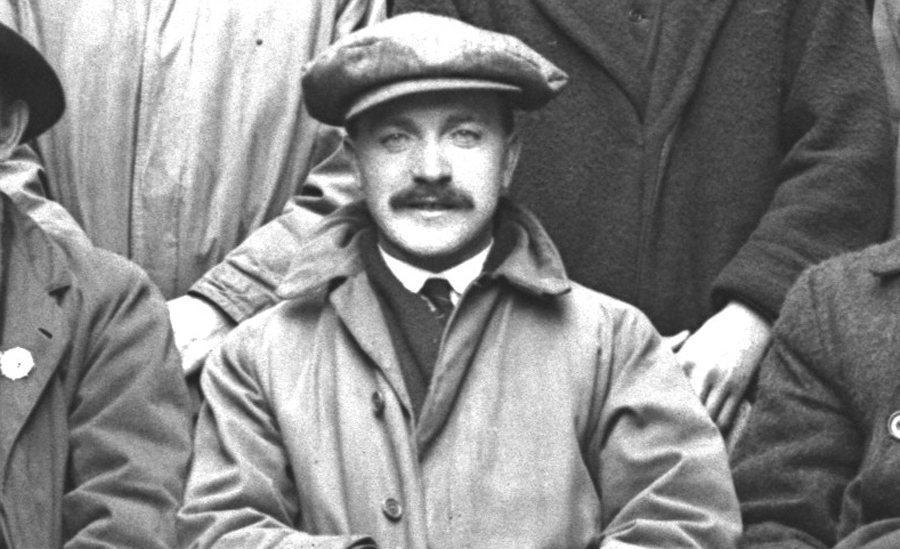Mac Curtain murdered by police directed by British government
Inquest names Prime Minister, Lord Lieutenant and Chief Secretary
Cork, 19 April 1920 - The Lord Mayor of Cork, Tomás Mac Curtain, was murdered in his home on 20 March by members of the police directed by the British government, according to the damning verdict of the jury at the coroner's inquest into his death.
-Inquest-into-the-Murder-of-Mac-Curtain-CE.jpg)
Scene from the inquest into the death of Tomás Mac Curtain (Image: Cork Examiner, 19 April 1920)
The public inquest sat daily for three weeks, concluding on 17 April, and examined over 100 witnesses, many of them police officers.
Having completed its work, the jury delivered the following verdict:
‘We find that Ald. Tomás Mac Curtain, Lord Mayor of Cork, died from shock and haemorrhage caused by bullet wounds; and that he was wilfully murdered under circumstances of the most callous brutality; and that the murder was organised and carried out by the RIC [Royal Irish Constabulary] officially directed by the British Government.’
‘We return a verdict of wilful murder against David Lloyd George, Prime Minister of England; Lord French, the Lord Lieutenant of Ireland; Ian Macpherson, late Chief Secretary for Ireland; Acting Inspector General Smith, of the RIC; Divisional Inspector Clayton, of the RIC; District Inspector Swanzy, and some unknown members of the RIC.’
‘We strongly condemn the system at present in vogue of carrying out raids at unreasonable hours.’
The unionist Irish Times has said that the guilty verdict against the police was a ‘foregone conclusion’, but the jury had surpassed itself with a ‘stroke of Celtic fantasy’ in naming Lloyd George and Ian Macpherson.
The paper proceeded to cast doubt on the judgement and the assessment of the evidence provided, including the finding of a policeman’s button close to the scene - ‘the recent killing and wounding of policemen must have made the capture of dozens of such buttons an easy task’, it suggested.
In contrast, the moderate nationalist Freeman’s Journal has defended the inclusion of the Prime Minister and Chief Secretary in the verdict, pointing out that it follows the precedent of the ‘black years’ of the famine when juries placed on record that the victims had been ‘murdered’ by then Prime Minister, John Russell.
This approach is designed to indict not individuals, but a system, and in this case the ‘ruthless repression, which the coalition government have pursued in this country, is no less responsible for the death of the Lord Mayor of Cork and for the tragedies that make the record of the last few months such terrible reading than was Lord John Russell... for the famine pits of Skibbereen.’
The Freeman claims nonetheless that the ‘mystery’ of the murder of the Lord Mayor has not been entirely cleared up by the inquest, not least the lack of accountability for the lax investigation which saw the offence not even entered in the barracks’ office book and the refusal of the Lord Lieutenant John French and his under-secretary Sir John Taylor to provide evidence.
‘When men in high places take such a view of their obligations is it difficult to guess what the effect is likely to be on those who exercise authority under them?’
Police involvement in other murders
It is not only in Cork where serious accusations have been
levelled against the RIC. The Irish Bulletin, the
newspaper of Dáil Éireann, has published the names
of a number of citizens which it claims have been murdered by
police and military forces in Ireland since 20 March.
This list includes Thomas Dwyer, whom a coroner’s inquest has found was murdered by unknown members of the RIC at his home at Bouladuff, near Thurles in Co. Tipperary last month.
Another case where foul play on the part of the police is alleged is that of Thomas Mulholland, 28, of Dundalk. The inquest into his death has been told that evidence will be produced that will ‘prove conclusively’ that Mr Mulholland was shot by the police.
Mr Mulholland was a yard worker for P. Deery, UDC, and a member of the Irish Volunteers. He was shot at 11pm on 16 April on Bridge Street after police claimed that two of their patrols were attacked.
-Dundalk-Tragedy-FJ.jpg)
The scene of the Dundalk tragedy, where Thomas Mulholland was killed (Image: Freeman's Journal, 20 April 1920)
[Editor's note: This is an article from Century Ireland, a fortnightly online newspaper, written from the perspective of a journalist 100 years ago, based on news reports of the time.]





















